Behavior Modification
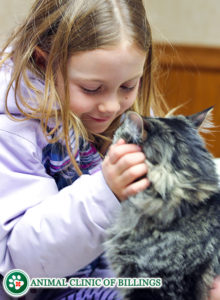 Behavior modification and counseling for cats and dogs is an ever-growing area of veterinary medicine. Many behavior modification strategies and medications exist to help our pets deal with anxiety, aggression, destructive behavior, inappropriate urination, and a variety of other behavioral disorders. Many of these problems are incredibly frustrating to owners and can oftentimes be helped with a wide variety of techniques.
Behavior modification and counseling for cats and dogs is an ever-growing area of veterinary medicine. Many behavior modification strategies and medications exist to help our pets deal with anxiety, aggression, destructive behavior, inappropriate urination, and a variety of other behavioral disorders. Many of these problems are incredibly frustrating to owners and can oftentimes be helped with a wide variety of techniques.
Problems in animals don’t always have a physical cause, and the sad truth is that more dogs are forfeited to shelters and put to sleep because of behavioral problems than the number of dogs that are euthanized because of actual health problems.
Our veterinarians and support staff have many years of experience diagnosing and prescribing treatment methods for dog and cat behavioral issues. Our vets can help determine the cause of behavior disorders such as inappropriate urination and aggression, and then develop an effective, humane behavior modification program.
The Animal Clinic of Billings offers behavior counseling for a number of issues affecting pets and can provide effective and appropriate recommendations for dog and cat behavioral problems. (Jump to Dogs)
BEHAVIOR MODIFICATION FOR CATS
Cat behavioral modification measures can ensure that your cat is a well-adjusted and enjoyable member of your family. From training kittens to addressing unwanted behavior in mature cats, our veterinarians can help you achieve a better bond with your furry friend. Oftentimes a behavior problem, such as inappropriate urination, can be linked to a medical issue (cystitis, bladder stones, and kidney disease).
Although there are many effective solutions to problematic pet behaviors available to us, it’s important to understand that rarely an animal’s behavioral issues are so severe or pronounced, that even our best medical remedies fall short in attempting to modify the behavioral problem. Oftentimes though, we are able to vastly improve or even eradicate the behavioral problem.
Some common behaviors treated with behavioral modification programs include:
Inappropriate Elimination
Urinating and defecating outside the litter box is the most common problem behavior we encounter in cats, and is one of the primary reasons cats are forfeited to shelters. While this is indeed a very frustrating situation to deal with, we want to assure you that most cases of inappropriate elimination can be successfully treated, and our veterinarians have helped many owners regain their sanity and harmonious relationship with their troubled feline.
Inappropriate elimination in cats can arise from multiple medical and behavioral causes. Medical conditions that can cause a cat to urinate outside the box include urinary tract infections, bladder stones, idiopathic cystitis (non-infectious bladder inflammation), kidney disease, diabetes, hyperthyroidism, liver disease, arthritis, and elevated blood calcium levels.
Defecating outside the box can occur due to any condition that results in constipation or intestinal discomfort. If no medical cause is found for a cat’s behavior, then a detailed history will be evaluated to determine the most likely behavioral cause. The most common behavioral reasons for inappropriate urination include urine marking and litter box aversion.
Urine marking is motivated by a desire to communicate a territorial claim, and is most frequently encountered in cats who are experiencing anxiety and a sense of insecurity in their environment. This may be set off by changes to the home (moving, new pet, houseguests, a new baby, absence of the owner, or a major change in routine) or stressful stimuli your cat can see and hear going on outside the home (construction, outdoor cats coming near the house, etc.).
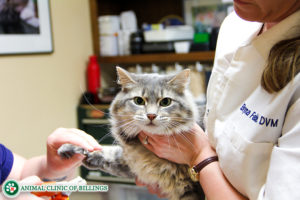 Both male and female cats engage in this behavior, and while it is more common in sexually intact cats, it is also seen in cats that have been spayed and neutered. A cat who is marking will often spray urine on vertical surfaces in strategic locations, such as on a door frame or in areas where their owner’s scent is the strongest (on bedding or laundry).
Both male and female cats engage in this behavior, and while it is more common in sexually intact cats, it is also seen in cats that have been spayed and neutered. A cat who is marking will often spray urine on vertical surfaces in strategic locations, such as on a door frame or in areas where their owner’s scent is the strongest (on bedding or laundry).
The strategy for treatment of marking behavior involves treating the cat’s underlying anxiety and thoroughly cleaning all marked areas with an enzyme-based cleaner to reduce attraction back to those areas. One useful tool is “Feliway” diffusers, which emit a synthetic copy of the feline facial pheromone that causes cats to feel confident and secure in their environment.
Our veterinarians can identify any other environmental modifications that may help to reduce your cat’s anxiety and prescribe anti-anxiety medication to improve their confidence and security so they will not feel the need to continue marking.
Litter box aversion is the other major cause of inappropriate elimination. In these cases, a cat urinates and often also defecates outside the litter box because they have developed a dislike for their litter box. Usually this involves a large volume of urine being deposited on a horizontal surface, usually on a soft substrate such as a rug or blanket.
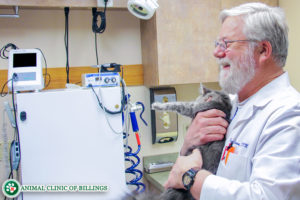 Reasons a cat may refuse to use their box include inadequate litter box maintenance, a dislike for the litter, placement of the litter box in a high traffic/stressful area, fear of entering a covered litter box, and experiencing a stressful or painful event while in the litter box. A thorough behavioral history will allow our veterinarians to determine which of these factors may be playing a role, and they will then advise you on the specific changes you can make to correct these factors.
Reasons a cat may refuse to use their box include inadequate litter box maintenance, a dislike for the litter, placement of the litter box in a high traffic/stressful area, fear of entering a covered litter box, and experiencing a stressful or painful event while in the litter box. A thorough behavioral history will allow our veterinarians to determine which of these factors may be playing a role, and they will then advise you on the specific changes you can make to correct these factors.
As with marking, it is also very important to thoroughly clean soiled areas with an enzymatic cleaner to reduce attraction and repeated incidents. Sometimes, litter box re-training is necessary, which involves confining the cat to a small room with a litter box and all their other necessities for a few weeks until they are consistently using their litter box again.
Aggression Toward People
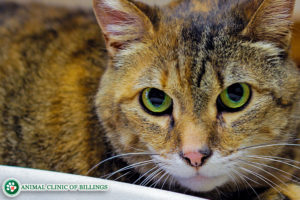 Usually when a cat behaves in an aggressive manner with their human family members, it is either due to overexcitement while playing, redirected aggression toward an individual they can’t get to (like a cat they see outside), or feelings of anxiety/stress. By taking a detailed behavioral history, our veterinarians can determine the underlying cause of your cat’s aggressive behavior, and help you implement a treatment program to correct it. In most cases, a significant improvement in signs of aggression can be achieved.
Usually when a cat behaves in an aggressive manner with their human family members, it is either due to overexcitement while playing, redirected aggression toward an individual they can’t get to (like a cat they see outside), or feelings of anxiety/stress. By taking a detailed behavioral history, our veterinarians can determine the underlying cause of your cat’s aggressive behavior, and help you implement a treatment program to correct it. In most cases, a significant improvement in signs of aggression can be achieved.
Aggression Toward other Pets
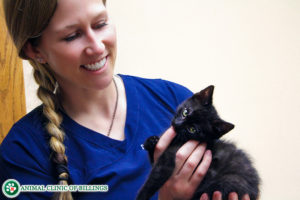 Conflict between cats in the same household is a common cause of stress for cats and concern for their owners. The potential causes of inter-cat aggression include conflict over territory and resources, social contention, redirection of aggression toward an inaccessible individual (such as an unfamiliar cat seen out the window), overexcitement, and anxiety.
Conflict between cats in the same household is a common cause of stress for cats and concern for their owners. The potential causes of inter-cat aggression include conflict over territory and resources, social contention, redirection of aggression toward an inaccessible individual (such as an unfamiliar cat seen out the window), overexcitement, and anxiety.
With an understanding of the underlying cause of aggression in a specific situation, changes can be made to alleviate the source of the conflict and restore household harmony. The general approach to conflict over territory and/or resources is to create a larger territory by taking advantage of vertical space and to provide an over-abundance of all essential resources (litter boxes, food and water bowls, toys, napping spots, scratching posts, etc.) distributed widely throughout the home.
These strategies can also be very helpful for issues stemming from social conflict and anxiety, as they allow a cat to engage in all important activities without having to approach or interact with another cat in the process. Especially important for an anxious or stressed cat is to have access to lots of perches and hiding spots where they can feel safe and secure.
Cats that get into fights due to over-excitement may need more one-on-one stimulation with interactive toys (laser pointer, feather wand, etc.) that can serve as a substitute for their usual target (the other cat). Food-dispensing toys can also be very helpful in dissipating excess energy. In cases of redirected aggression, the stimulus must be identified and blocked. This can be tricky as often the trigger is outside and not in your control (like a neighbor’s outdoor cat), but usually with some creative thinking some changes can be implemented to limit exposure.
Usually, the first step in addressing inter-cat aggression, regardless of the underlying cause, is to physically separate the cats until appropriate changes to the environment can be implemented, and until both cats have settled down. Your veterinarian will then instruct you on how to gradually reintroduce them in a positive and low-stress manner.
In some cases where anxiety is motivating aggressive behavior, anxiety medication may also be helpful. Another useful tool is “Feliway Multicat” diffusors, which emit a synthetic version of the pheromone produced by a mother cat to stimulate bonding with and among her kittens. This social bonding pheromone can help to stimulate feelings of kinship and group cohesion that can alleviate conflict. The last resort if aggression between two cats does not improve with sustained efforts is to rehome one of the cats, but this is rarely necessary.
Destructive Scratching
While scratching is a normal and healthy feline behavior, it can become quite a problem when the target of this activity becomes our furniture, carpets, and curtains. Fortunately, there are a number of strategies that can be effective in protecting our homes from feline damage. 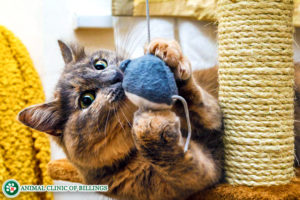
One of the most effective interventions is to offer your cat alternative, more appealing options to fulfill their natural desire to scratch. Scratching posts and horizontal mats made of attractive material such as sisal, cardboard, and bark should be placed in areas frequented by your cat. These should be large enough for your cat to full stretch out on. To make these even more attractive, catnip can be applied to the posts.
Measures should also be instituted to make their previous scratching targets less appealing, such as covering them with plastic, aluminum foil, or double-stick tape until the cat has become accustomed to using his or her new scratching posts.
For cats who continue to scratch where they shouldn’t, claw caps (“Soft Claws” and other brands) should be tried. These comfortable plastic caps are contoured to a cat’s claws and have blunt tips. They are glued onto a cat’s claws so that when they scratch, it is much less likely they will cause any damage.
Most cats will try to chew them off at first, but after a few weeks, they become used to their new accessories and tolerate them well. As the outer surface of each claw naturally sloughs off, the caps will need to be replaced. One set will last a cat about a month.
Introducing a New Cat to the Household
It can be a very stressful experience integrating a new feline friend into the family. Will he/she get along with the resident cat(s)? What about the kids and the dog? As we all know, cats hate changes, but there are some strategies you can employ to help ease the transition and increase the odds of a successful introduction.
When a new cat or kitten is first brought home, they should be confined to their own room, with a litter box, food, water, and toys. No other pets should be allowed in here—this is their “safe space” as they acclimate to the scents and sounds of your household. They should have access to a hiding spot (such as under a bed), and be allowed to come out and explore the room on their own schedule.
Spend as much time as possible in the room both actively interacting with your new cat as well as doing other things—watching TV, reading a book, etc.—so they become familiar and comfortable with you. As long as they are actively exploring and seem relaxed, other human family members can also start to spend time bonding with them as well. Exchange small towels or other bedding items between the new cat and your resident pets, so everyone can become accustomed to everyone else’s scents. 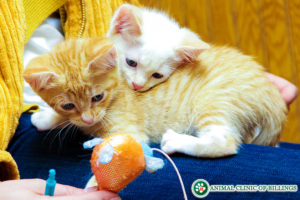
After at least a few days, once the new cat is comfortable and confident in their room, confine your other pets and allow your new friend to explore the rest of the house under your supervision. Supervised excursions like this can be gradually increased in length until they have become familiar with the layout of the house and the location of litter boxes, food and water, and spots to hide and feel safe. Once this point is reached, formal introductions can be performed.
It is best for the new cat and any resident cats to first view each other from a distance. This can be done by putting them in separate kennels or carriers positioned at opposite ends of a room so they can get a good look at each other, but cannot interact. Pairing this with treats or a meal can help to create a positive mental association. Once everyone seems calm and disinterested, the next step is to confine the new addition to a large kennel and allow the resident pets to approach and interact in a limited way. Again, pairing this experience with extra tasty treats or a special meal can make this a positive experience.
After the resident pets have investigated and lost interest, switch everyone’s positions to allow the newcomer to approach the kenneled resident animals. Finally, supervised direct interaction should be permitted for gradually increasing periods of time until everyone has settled down to “business as usual.” This entire process may take as little as a few days or as long as several weeks, depending on the temperaments of the animals involved.
Starting your New Kitten Off on the Right Paw
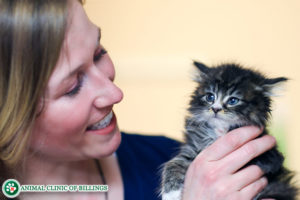 Behavior problems are always easier to prevent than they are to treat, and there are a number of things new kitten owners can do to reduce the risk of behavior problems developing down the road. First and foremost, a kitten should be introduced to as many different things as possible that they may encounter in their life by the age of 9 weeks. During the 3-to-9-week-old window, kittens will readily accept and become comfortable with new things they encounter and will be much less likely to become anxious or aggressive if faced with them again in the future.
Behavior problems are always easier to prevent than they are to treat, and there are a number of things new kitten owners can do to reduce the risk of behavior problems developing down the road. First and foremost, a kitten should be introduced to as many different things as possible that they may encounter in their life by the age of 9 weeks. During the 3-to-9-week-old window, kittens will readily accept and become comfortable with new things they encounter and will be much less likely to become anxious or aggressive if faced with them again in the future.
Make sure many people of different genders, ages, and appearances, gently handle and play with your kitten. If possible, introduce your kitten to a relaxed, friendly dog or two, and get them used to confinement in a carrier and car rides. Offer them foods of different flavors and textures (kibble, semi-moist, canned, chewy treats, etc.) to minimize the chance they will become a picky eater.
Get them used to having their ears, mouth, and paws handled, and introduce them to nail trimming. Engage in frequent interactive play sessions to help your kitten learn to expend their energy in a non-destructive way, and make sure favorite toys are always available for independent play. Kibble-dispensing toys are another great form of environmental enrichment to keep your kitten out of trouble when on their own. Pair all new experiences with tasty treats and fun toys to ensure that a positive memory is formed.
Kitten classes are a great aid to socialization and basic training, and are available in most areas. Once your kitten has had his or her first round of vaccines, they can safely attend kitten classes.
BEHAVIOR MODIFICATION FOR DOGS
The Animal Clinic of Billings offers behavior counseling for dogs exhibiting problematic behavioral issues such as separation anxiety, inappropriate defecation or urination, aggression, and inappropriate chewing and barking, as well as any animal conflicts that have resulted with an already existing pet from introducing a new dog or cat into your household. Many times a dog’s behavior problem can be brought on by a medical issue such as bladder stones, cystitis, or kidney disease, so a thorough veterinary examination is very important.
Although there are many effective solutions to problematic pet behaviors available to us, it’s important to understand that sometimes an animals behavioral issues are so severe or pronounced, that even our best medical remedies fall short in attempting to modify the behavioral problem. Oftentimes though, we are able to vastly improve or even eradicate the behavioral problem.
Some common behaviors treated with behavior modification programs include:
AGGRESSION TOWARDS PEOPLE OR OTHER DOGS
Aggression towards people or other dogs is the number one reason dog owners seek dog behavioral help. Aggression may target people or other animals, and may be motivated by several different impulses. The best strategy for fixing aggression depends on which one of these impulses is causing the behavior. Fear or anxiety-based aggression, territorial aggression, aggressive pain-reactivity, resource-guarding aggression, redirected aggression, protective/defensive aggression, predatory behavior, and aggression related to abnormal brain activity may occur alone or in combination.
In these cases, a medical workup including a complete physical exam, bloodwork, and possibly x-rays, should first be performed to rule out any possible medical causes for the aggressive behavior. If a medical cause is found, an appropriate treatment plan will be instituted to alleviate the condition. If no medical cause for aggression is identified, the veterinarian will then collect a detailed history of the behavior, including meticulous descriptions of the conditions preceding, concurrent with, and following the aggressive behavior. Based on this history, the veterinarian will determine which type(s) of aggression is/are present and will design a treatment program to address the behavior and its motivating causes.
A typical treatment plan will include components of environmental management (such as avoiding triggers) and behavioral modification measures (such as desensitization and counter-conditioning). This program will require time, effort, and consistency on the part of the owner, but will often pay off as the dog’s aggressive behavior decreases over time. Periodic rechecks are important in these cases to discuss a dog’s progress and modify the treatment program as necessary. Once the aggressive behavior is fully under control, the measures that have proven effective must be continued indefinitely in order to avoid recurrence.
BARKING
Barking is the main form of vocal communication for a dog, so barking is usually intended to get your attention or alert you to something concerning. Many times, a dog will also bark to communicate a perceived unmet need like he or she wants food, water, or attention for example. However, barking can also be motivated by anxiety, boredom, or excitement. When barking becomes incessant, it can become a serious problem for you, your family, and your neighbors. To address such a situation effectively, the dog’s motivation for barking must first be determined.
By collecting a thorough history of your dog’s barking problem, your veterinarian can determine what is driving the behavior. Once their reason for barking is understood, measures can be instituted to decrease their motivation. These measures will vary widely, but may include avoiding stimuli and teaching calm behaviors for an excitable barker, ignoring an attention-seeking barker until they are quiet, environmental enrichment for dogs barking out of boredom, and instituting measures to reduce anxiety for a stress-barker.
Punishment and shock collars are not recommended, as these often increase fear and anxiety and do not address the underlying motivation for the behavior. With detailed guidance and consistent work, most barking problems can be significantly improved.
CHEWING AND MOUTHING
Chewing is a natural behavior in puppies, being one of their primary methods of exploring their environment, as well as a means of alleviating the discomfort of teething. Chewing in mature dogs is usually motivated by play, boredom, anxiety, or habit. There are many strategies that can help control destructive chewing.
Crate-training your dog is one of the most effective ways of preventing damage. For smaller dogs, baby gates can be used to prevent access to areas of the house containing chewable items. Providing an abundance of appealing and safe chew toys can help to channel their impulses to more acceptable targets. Rubber Kong toys can be stuffed with canned food, peanut butter, or soft cheese and frozen to provide a long-lasting distraction. Pet Safe produces a variety of food-dispensing chew toys that most dogs love.
If your dog has a habit of chewing up and/or swallowing items they find on the floor, be meticulous in picking these up and storing them out of reach. If you find that an item has been chewed up and there are pieces missing, it is possible your dog may have swallowed them. If any of these pieces of material are too large to pass through the intestine, surgery may be necessary to remove them to avoid serious tissue damage. As this can be potentially life-threatening, any dog that has swallowed non-digestible material should be monitored very closely and taken to the veterinary clinic at the first sign of GI upset.
While this is perfectly normal dog behavior, mouthing can also lead to biting and potentially serious injuries. If your dog begins to nip or bite you, other people, or other animals as a way of playing, we recommend seeking veterinary advice and a proper dog training program ASAP.
SEPARATION ANXIETY
Separation anxiety is by far one of the most common behavioral problems encountered in dogs. Dogs with separation anxiety experience severe stress and agitation when left alone for any period of time. This commonly manifests as destruction of material inside the house, excessive vocalization, and house soiling, and may even result in self-injury.
Dogs that experience separation anxiety are typically hyper attached to their owner and have never learned to be calm and confident when alone. This frustrating and stressful condition can be treated with a combination of techniques encouraging independent activity, desensitizing them to clues that you are preparing to leave, and counter-conditioning them by providing a soothing and reassuring environment with high-value toys and treats when alone.
Often anxiety medication is also necessary. Our veterinarians are experienced in the treatment of separation anxiety and other anxiety disorders in dogs. Call to schedule a veterinary consultation with one of our vets if you feel your dog is suffering from separation anxiety.
NOISE PHOBIAS
Noise phobias in dogs are not uncommon. A dog with a noise phobia will exhibit signs such as hiding, shaking, panting, drooling, whining, and trying to escape from a room or enclosure when they hear specific types of loud noises. The most common stimuli for noise phobia in dogs are thunderstorms and fireworks. The cause of these phobias is not known for sure, but it is believed that both genetics and lack of exposure to the specific noise during puppyhood play a role.
Treatment for noise phobias typically involves both behavioral modification techniques (distraction, limiting exposure, creating a calm environment, gradually desensitizing to the stimulus) and calming medications. Our veterinarians successfully care for many noise-phobic dogs; if your dog shows signs of panic during storms, fireworks, or any other loud noises, call to schedule an appointment to discuss treatment.
EATING FECES
The ingestion of feces (a dog’s own or another animal’s) is a normal behavior in young puppies and lactating mothers that sometimes persists into adulthood and can be very distressing for owners to witness. In a minority of cases, coprophagia can be motivated by an insufficient diet, intestinal parasites, the presence of GI diseases that interfere with digestion and absorption, or the presence of diseases that inappropriately stimulate feelings of hunger, such as hypothyroidism, Cushing’s Disease, and diabetes. All dogs who routinely engage in coprophagia should have a veterinary workup to rule out the presence of a medical cause for the behavior.
Most dogs who engage in this have a behavioral motivation. Anxiety, stress, and boredom can all cause this behavior to develop and continue. If a medical problem has been ruled out, there are some behavioral interventions that can be effective in reducing this behavior. Prompt removal of all feces will deprive a dog of the opportunity to consume them.
This may be sufficient to break the habit for some dogs. Sometimes a diet change can have an effect, likely resulting from a change in the consistency and flavor of the feces. Dietary additives fed to the animal whose feces are being consumed are designed to make feces have an unpleasant taste. These have highly variable efficacy, but are sometimes worth a try. If stress or anxiety are at the root of the behavior, a program of environmental and behavioral modification should be implemented.
If feces ingestion is motivated by boredom, environmental enrichment and increased physical activity may be helpful. Our veterinarians can help you determine the likely cause of your dog’s behavior and design a treatment program.
HOUSE SOILING
There are numerous potential reasons why your dog may start urinating or defecating inside the house. First it is important to rule out potential medical causes, such as a UTI, bladder stones, kidney disease, diabetes, Cushing’s disease, female incontinence, and GI diseases. If no medical condition is present, then behavioral causes, such as incomplete house training, anxiety, territorial marking, and senility, may be present. A complete history of the behavior will enable our veterinarians to determine the underlying cause of your dog’s accidents and design a treatment plan.
JUMPING UP
Jumping up on people is an attention-seeking behavior that most of us inadvertently reinforce by giving them the attention they seek. Even scolding the culprit is a form of attention, so the dog will still feel that he or she has succeeded. To prevent this habit in a puppy, only give them attention (of any kind) when all four paws are on the ground. Everyone who interacts with your puppy should be instructed to do the same. In this manner, the behavior is never reinforced, so they stop trying.
Dogs that have already acquired this bad habit can be re-trained, but it will take more time and effort. Usually the most effective method is to train the dog to sit when he or she wants attention, while at the same time ignoring them any time those front feet leave the ground. This may take a lot of time, patience, and consistency. It is best to start this process in a calm, quiet environment without any excitement or distractions, and gradually extend it into more dynamic and challenging environments.
SCHEDULE A VETERINARY APPOINTMENT WITH US
If you would like to discuss behavioral concerns with one of our veterinarians, please contact us to schedule an appointment. Our veterinarians are here to help address your pet’s behavioral problems and educate you on how to effectively and humanely keep your canine companion safe, happy and well behaved.

Let our highly trained and experienced team of veterinarians and veterinary technicians help you keep your pet as happy and healthy as they can be.
Call the Animal Clinic of Billings and Animal Surgery Clinic to schedule your pet’s next wellness examination with us today!
406-252-9499 REQUEST AN APPOINTMENT



